Bushcraft–the art of living off the land and thriving–is considered primitive by urban standards, but it is a low stress world that you build for yourself and your family. Sometimes it is hard to explain the joy and the sense of pride you feel when you know how to build your home, grow your own food, thrive, and prosper where many others cannot.
This life style is usually voluntary in countries such as the US, Canada, The United Kingdom, Australia, and South Africa. As an Eagle Scout, bushcraft was a way of life for me too. Through the long journey from Tenderfoot to Eagle Scout you develop a love and understanding for this way of life.
But in a post-crisis scenarios you may have to survive in non-urban and/or hostile conditions for months, years, or the rest of your life.
Are you prepared to survive like this?
The 5 Tools that You Need
When you are living off the land, there is no way to go to a store and buy the tools you need. Therefore, bushcraft also encompasses making the tools you need in order to achieve all of your objectives and making purchased ones last as long as possible.
{adinserter usf}Depending on the geographic location, you will find that indigenous people have their own unique designs for locally fabricated tools.
In a post crisis scenario, having an eye for tool design and cultural markings can be an important part of being able to communicate effectively with other groups and gain a faster understanding of their intent, outlook, and past actions towards strangers.
There are five types of bushcraft tools (fixed blade knives, hatchets, axes, saws, and machetes) that you should be able to create, use, and maintain in wilderness settings.
While you can buy all of the tools listed in this article, being fully prepared for any crisis means that you can also manufacture serviceable items from natural materials. Consider studying metallurgy, stone knapping, whittling, and geology (in order to know which rocks carry metal ores of interest, etc.)
1. Fixed Blade Knives
The fixed blade knife should be a well-built knife that will give you years of good service without breaking or badly rusting. These knives are best suited for light to medium field duty as carving or whittling, skinning game, making snares and traps, preparing food, or cutting down branches smaller than your wrist.
How to Clean Your Knives
Always keep your knife clean, clean the blade and handle after each use. Do not soak the knife in water. Instead use a mild solution of soap and water on a clean rag or paper towels should remove any dirt and debris that may have accumulated during use.
Keep your fixed blade knife dry. After cleaning or exposing the knife to moisture the knife most be completely dried. Use WD-40 on the blade only to displace any moisture to prevent water spots and oxidation from forming. Then oil all metal parts. Remember to oil the knife regularly. Finger prints and weather are the primary cause of rust and corrosion.
Keep your knife sharpened. A sharp knife is safer and easier to use than a dull one. If you are new to knife sharpening use a fixed angle sharpening kit. This will give you a consistent grind from tip to base. Practice your knife sharpening skills on cheap knifes instead of expensive knives.
How to Store Your Knives
When not in use oil the blade and store the knife in a cardboard sheath. Do not store the knife in a nylon or leather sheath that came with the knife because it traps moisture and cause the knife to rust. A cardboard sheath will wick the moisture away from the blade’s surface and prevent dust from accumulating. Keep this knife stored in a cool low humidity area while in storage.
There are a few knives that I would recommend for bushcraft. Keep in mind that all the prices that you will see below are the manufacturer’s suggested retail price for each item.
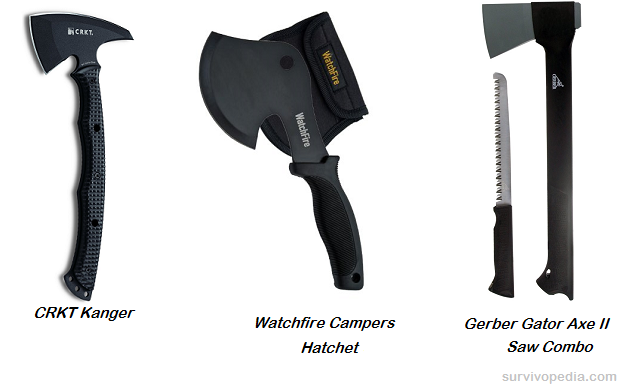
Ka-Bar Becker 22 MSRP – $121.45
- Heavy duty field utility knife with HD Polyester front pocket sheath.
- Over all length 10.5”
- Blade 5.25”
- Wt.14.6 oz.
- Made of 1095 Cro-Van Steel
- Flat ground drop point edge
- Full tang with glass breaker in the pommel.
- Unbreakable Grivory grips.
Condor Tool and Knife Hudson Bay MSRP – $69.98
- Heavy duty field utility knife with leather sheath.
- Over all length 13”
- Blade 8.5”
- Wt. 20.5 oz.
- Made of 1075 high carbon steel
- Wood grips
- Classic design well made knife. Heavier than most.
Ka-Bar Straight Edge Knife MSRP – $103.95
- Heavy duty utility knife with a heavy leather sheath.
- Over all length 11.75”
- Blade 7”
- WT. 16 oz.
- Made of Carbon Steel
- Leather grip
2. Hatchets or Axes
These a small, highly versatile, non-precision wood cutting bushcraft tools well suited for heavier tasks such as chopping wood or down trees, splitting logs, butchering large animals, digging, or hammering in stakes and posts.
How to Clean Your Hatchets or Axes
The first step in cleaning your axes or hatchets is to make sure that the head is completely dry. Use a dry cloth or paper towels to remove excess water from the head. To remove any stubborn dirt or wood sap from the hatchet or axe, use turpentine on the head and handle.
If you find rust on these tools while inspecting them, use sandpaper or fine steel wool (000 grid) to remove the rust. Remember that rust is the silent destroyer of metal axes or hatchets. Today there are many ways to prevent your axes and hatchets blade from rusting.
- You can spray or wipe on light lubricants or oils on the blade of these tools after you use them. Light oils do not tend to gum up even in the cold temperatures.
- If you use your axe or hatchets a lot, you can use gun oil as a cleaner and anti-rust protector.
- Some people use motor oil to clean and protect the axe and hatchet head from rust and to protect and lubricate these tools.
- The use of car or floor wax can be used to inhibit the rusting of an axe or hatchet by putting a waterproof barrier on the tools.
- There are some old timers that use either beeswax or linseed oil to prevent rust on axes or hatchets. Both will protect these tools by putting a waterproof barrier on the tools.
- Always keep your axe or hatchet well sharpened. A sharpened axe or hatchet is safer and easier to use than a dull one.
How to Store Your Hatchets or Axes
When you store your axes or hatchets be sure that you clean and apply a rust inhibitor on these tools and wipe off all excess. Next cover the axe or hatchet head with a cloth or sheath. Keep these tools in a safe, cool, and dry place with low humidity. Many people leave these tools in a stump by the wood pile. While these tools will take this type of “storage” for some time, they will still wear out and be ruined faster than if they are cared for properly.
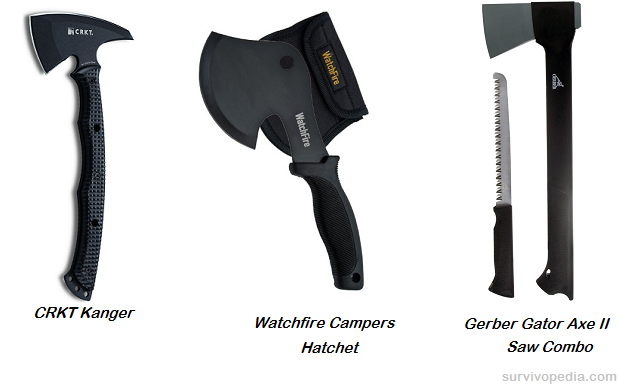
Hatchets that I would recommend for bushcraft:
CRKT Kangee MSRP – $185.00
- Heavy duty hatchet with nylon sheath.
- Over all Length 13.75
- Blade length 2.93”
- Thickness 0.23”
- Weight 1.5 Lbs.
- Blade material SK-5 carbon steel
- Finish black powder coat
- Features sharpened spine and beard.
- Has multiple grip options.
Watchfire Campers Hatchet MSRP – $13.95
- Compact medium duty hatchet with nylon sheath.
- Over all length 10”
- Blade length 4.5”
- Thickness 0.23”
- Weight 13.6 Ozs.
- Blade material stainless steel black coated blade.
- Features a large head and compact slip resistant handle.
- Black nylon sheath
Gerber Gator Axe II Saw Combo MSRP – $30.00
- Heavy duty hatchet with nylon sheath.
- Over all length 15.2” long.
- Blade length 2.7”
- Weight 1.8 Lbs.
- Blade material forged steel with black coated blade.
- Features a saw stored in the handle made of glass filled nylon ( extremely strong).
- Black nylon sheath
3. Machetes
You could say that a machete is a hybrid between a large knife and an axe or hatchet. It can be used for many of the lighter jobs of an axe or hatchet. With a long heavy blade it is a good cutting tool.
Machetes are useful for clearing brush, cutting up large branches, chopping smaller logs for fires, or digging. Some machetes are sickle hooked for removing vines.
How to Clean Your Machetes
Machetes must be kept clean and the blade well oiled. Never soak the machetes in water to clean them. Instead use soap and water solution on a clean rag to remove any dirt or debris that accumulated during use. After cleaning, or if the machetes were exposed to moisture, they must be dried.
Use WD-40 to displace the moisture to prevent rusting of the blade and other metal parts, then put a light coating of oil on the machetes to prevent rust and corrosion. Do not forget to oil the machete blade and all metal parts regularly.
Keep the machetes sharp. A sharp machete is safer and easier to use than a dull and chipped one. Machetes can be sharpened with sharpening stones or metal sharpening tools.
How to Store Your Machetes
If you do not plan to use your machete for a while oil the blade and store in a cardboard sheath. This will keep the machete blade moisture and rust free. Keep the machete stored in a cool low humidity area. Only keep a machete in it’s sheath if you plan to be wearing and using it.
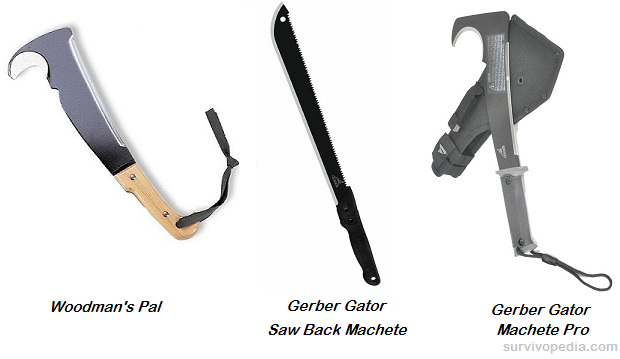
Machetes that I would recommend for bushcraft:
Woodman’s Pal MRSP – $97.00
- Heavy duty machete with nylon sheath and sharpening stone.
- Over all length 17” long.
- Blade length 11” long and 1/8” thick.
- Weight 1.4 Lbs.
- Blade material cold rolled steel hardened to C47.
- Features was designed as a Bushcraft tool, the heavy blade will cut 1.5” branches in a single stroke, and with the sickle hook is excellent for cutting vines and briers.
Gerber Gator Saw Back Machete MSRP – $29.95
- Heavy duty machete with a nylon sheath.
- Over all length 25.7” long and 1/8” thick.
- Blade length 18”, 15” fine edge with a 18” saw edge.
- Weight 18 Ozs.
- Blade material is high carbon steel.
- Features a non-slip rubber grip.
Gerber Gator Machete Pro MSRP – $68.96
- Heavy duty machete with a military grade nylon sheath and sharpening stone.
- Over all length 16.5” long and 1/8 thick.
- Blade length 10.5”
- Weight 17.9 Ozs.
- Blade material is high carbon steel.
- Features a sickle hook that is excellent to cut down vines and briers.
4. Saws
A saw is a specialized bushcraft tool that is used to cut wooden branches for projects such as building platforms, huts, storage buildings, camp chairs and tables, constructing bush ladders, or cutting firewood
How to Clean Your Saws
Clean after every use. A build up of sap or debris can dull the cutting surface, which results in more work and less effective cuts. Some saw users clean saw blades with alcohol to remove sticky residues. If this does not work use a little kerosene on a rag to cut through the gunk. Wash and dry the saw thoroughly after cleaning. Spots of rust can be removed by using sandpaper or steel wool (000 grid).
After cleaning inspect the teeth of the saw. Be sure that there are none missing or cracked. If the blade is damaged, replace it. Using a damaged blade is dangerous due to chance that it might break during use, since it requires more pressure to saw though wood. After inspecting the saw blade and making sure it is in useable condition, oil it to prevent the blade from rusting.
How to Store Your Saws
When not in use be sure that the saw is clean and oiled to protect it from rust and moisture. Keep it in in a cool and low humidity area. Also keep the saw in an area that is out of the way so other people will not trip over it.
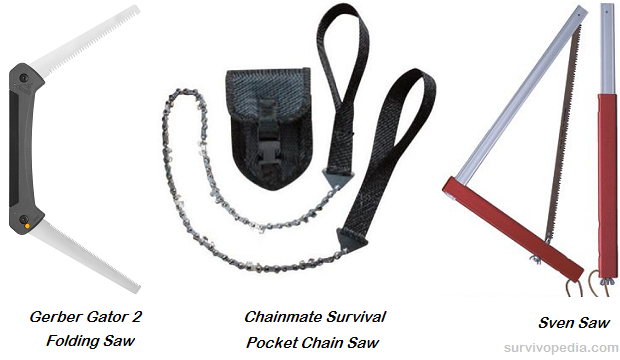
Saws that I would recommend for bushcraft:
Gerber Gator 2 Folding Saw MSRP – $44.60
- Heavy duty two bladed folding saw.
- Over all length 20 inches open, 12” closed.
- Blade length 10” each.
- Blade materials are hardened carbon steel.
- Weight 12.2 Ozs.
- Features two saw blades one fine, the other coarse.
Chainmate 24” Survival Pocket Chain Saw MSRP – $24.99
- Heavy duty manual chain saw.
- Over all length is 36” with grip loops.
- Saw blade length is 24” long.
- Blade is made from stainless steel.
- Light weight, but very strong.
- Features, can be made into a bow saw by attaching the grip loops to a stick.
- When not in use it can be packed up into it’s own ultra-lite compact nylon pouch.
Sven Saw 15” MSRP – $33.49 or 21” MSRP- $36.90
- Is a folding saw that is easy to unfold to make an excellent bow saw.
- There are two blade lengths 15” and the 21”.
- When folded the 15” saw are 17”X1 3/4 X 5/8 closed.
- When folded the 21” saw are 24” X 1 3/4 X 5/8 closed.
- The blade is made of good Swedish tool steel.
- This saw is a fast cutting package that will give you years of good service.
5. Bushcraft Backpacks
No matter whether you are going to stay in a narrowly defined wilderness area or move around frequently to hunt or accommodate seasonal changes, a backpack is absolutely essential. You can use the backpack to carry tools, supplies, navigational aides, and anything else that may need to be gathered up quickly or used in remote locations.
Aside from buying a backpack, they can also be made from animal skins or woven from plant stems and leaves.
Take the time now to learn how indigenous people in your prospective bug out area make backpacks or other types of carrying pouches. This can help you blend in the local area and also ensure that you know how to avoid mildew and other problems that will ruin most fabrics and other materials.
It should also be noted that backpacks do require maintenance such as sewing up holes that develop and ensuring that the fabric remains dry and clean. A good backpack can last for decades if taken care of properly.
For the bushcraft practitioner it is important that your backpack meet the following critical requirements:
- Make sure you pick a pack that has a frame on it and fits you comfortably.
- The backpack is waterproof.
- Has multiple compartments instead of just one large one.
- Materials are durable enough to hold projected weight without tearing, stretching, or being ruined in some other way.
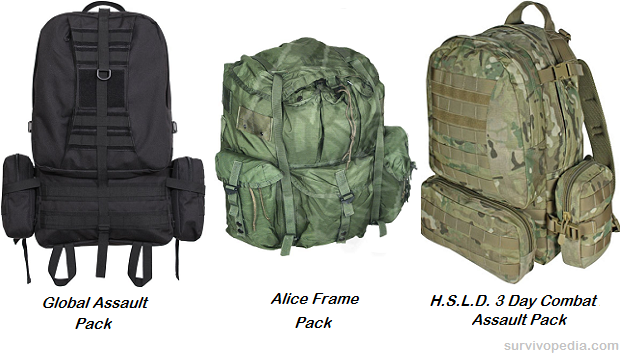
Recommended backpacks:
Global Assault Pack MSRP – $134.99
- Large pocketed pack with many small pockets.
- Can carry all of your Bushcraft tools, clothes, and other gear for short to medium trips to the woods.
- The pack comes in, Black, Tan, OD, or Army Digital.
Alice Frame Pack MSRP $88.89 – $94.99, depending on size
- Is my favorite and the pack that I personally use.
- This is the pack that all other packs are judged by.
- The pack has 1 large compartment and 6 smaller pouches to organize your gear.
H.S.L.D. 3 Day Combat Assault Pack MSRP – $89.95
- Modern military assault pack.
- The pack has 7 compartments, 1 large and 6 smaller pouches to store your gear.
- The pack weights 6 Lbs.
- Available in OD, Black, Coyote, Multicam, or Army Digital.
In today’s modern world, the old ways known as bushcraft are making a big comeback. Here a person or a group can build long term shelters, build fires without matches, forage for food by hunting, fishing, trapping, knowledge of edible plants, gather, and purify water.
When combined with successful care and management of bushcraft tools, you and future generations should be able to survive in the wilderness indefinitely. Just as your ancestors did for thousands of years before the modern era.
This article has been written by Fred Tyrell for Survivopedia.
[yasr_visitor_votes]





























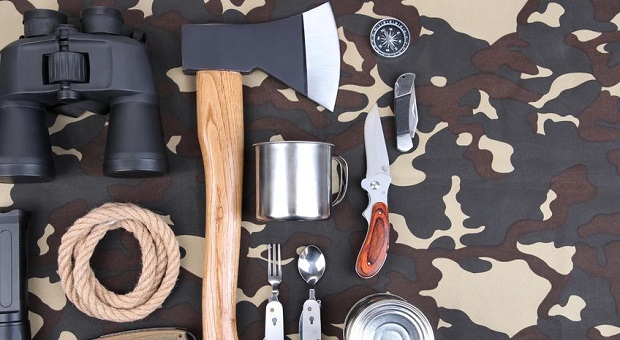













































My husband loves camping and survival trips, so these 5 tools would be really interesting to him. For his birthday, maybe I should get him one of these tools. I like the sound of the saws with a folding saw blade, or the machete with the built in blade.
great features! I got to step up my game! Love the dresser makeover! Amazing!
Every primitive society has as a fundamental tool, an axe but it’s often overlooked by many. It’s probably the most simple but also one of the most effective tools going around. Good tips on storing and cleaning your axe.
If you want something really light and effective try the bahco laplander. It’s a saw made in Scandinavia, it’s cheap and it’s awesome.
I’d ditch the machete and replace with a pot or large cooking cup.
This list is awful. Seriously. Why the hell would anybody want all of those? Anybody who is into bushcraft of any sort should know that you can do most camp tasks with a good axe and a knife. No need for a machete or a saw on top of that. The axes you recommend are mostly crap, if you want a good axe go American (council tools) or Swedish forged (wetterlings, gransfors, hultafors, etc) Even the knives you recommend are usually to big for most tasks or for being a handy all around bush knife. The only one suited is the kabar, the blade shouldn’t be more than 6 inches but whatever floats your boat I guess. I advise people to read Nessmuk and Horace Kephart. Less is more.
the only practical knife in this list is the becker, and even then, less expensive options are out there. oh and forget the ka bar combat knife. it’s crap for bushcraft, and this is why. the tang is narrower than 1/2 the blade width and features square transitions at the blade tang junction; which cause major stress risers. in short, any serious impact or bending stress in that spot will snap it (which theyr’e famous for). even a lauri leuku 180 or 175 is better than that, and the blades are only 1/8 inch thick. downside is though, you have to make the handle and sheath; which isn’t good for the “gotta have it now” type who don’t want to put out any effort and want it off the peg.
the axes here are crap and could be outdone by an estwing.
the machete is only good for areas with heavy vege, not the scrub. if you need a larger blade for out in the scrub, anything around 8 – 9 inch would do fine. personally, my knife set is a lauri 120 and a 145, coupled with a 3.5 inch pocket knife. with those, i can do anything carving/light chopping wise.
there’s no reason in the world why you should spend over $30 on a saw. a 6.5 inch corona pruning saw can be had for around $15.
alice pack for nearly $100? where do you shop? they’re around $40 at the surplus shops. no need to get one brand new.